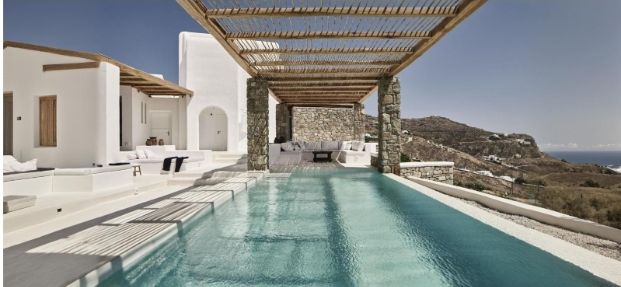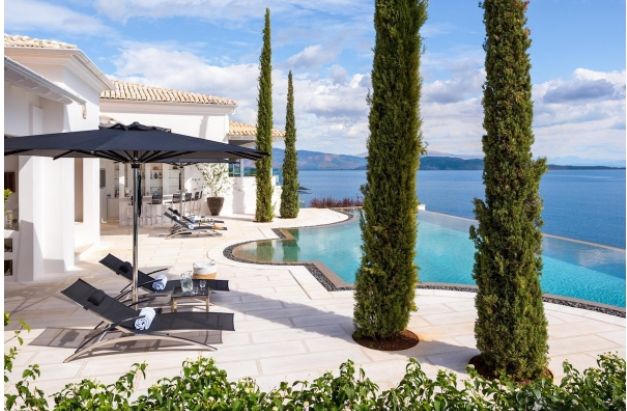
When the sun rises over Anguilla’s Meads Bay, the island is almost disarmingly still. The surf is soft, the palm trees barely move, and the only real commotion is inside one of the low-slung villas tucked discreetly above the sand. A private chef is plating breakfast for a family that has, by design, nowhere they urgently need to be: calls taken from a shaded terrace, teenagers drifting between the pool and the sea, grandparents already plotting the evening’s rum tasting.
For Sabrina Piccinin, founder of Haute Retreats, this is the new centre of gravity in luxury travel: not a lobby or a suite number, but a house that feels briefly, convincingly, like your own.
“Most of our guests could book any hotel in the world in five minutes,” she says. “What they want now is a place where the staff know their names, where the kitchen feels familiar, where their children can leave things on the table and no one blinks. A villa lets them exhale in a way a hotel rarely can.”
In an increasingly crowded luxury villa market—flush with booking platforms, glossy aggregators and social media “must-stays”—Piccinin is betting that less might actually be more. As she prepares to roll out a significant expansion across Spain, Greece, France and the Caribbean, including flagship estates in Anguilla, for Spring and Summer 2026, Haute Retreats is deliberately avoiding the race to list everything, everywhere.
The goal is narrower: to be the name travellers call when they want a villa that doesn’t feel like a villa rental at all.

Choosing depth over scale
The story of Haute Retreats is not of a tech juggernaut, but of an obsessive curator. Piccinin started the brand in 2016 with a handful of homes she knew personally, often meeting owners, walking the grounds and imagining the kind of guest each place would attract.
Nearly a decade later, that approach hasn’t softened. “For every villa we accept, there are many we don’t,” she says. “It’s not just design or price. It’s: does this house have a soul? Is there something about it that will stay with you years after you leave?”
The 2026 expansion is, in many ways, a stress test of that philosophy. Instead of simply adding pins to a map, Haute Retreats is threading a deliberate route through some of the most competitive corners of the villa world:
Spain, where the Balearic Islands and Costa del Sol have become shorthand for summer excess.
Greece, where whitewashed Cycladic homes compete for attention with cliffside pools and sunset views.
France, where the Riviera and Provence remain perennial magnets for old and new money alike.
And the Caribbean, where private compounds on islands such as Anguilla are quietly redefining what “barefoot luxury” can mean.
“In every one of these places, there are already thousands of options,” Piccinin admits. “Our job is to be the filter—not just another storefront.”
The Mediterranean, re-edited
If the Caribbean represents the slow, salt-bleached heartbeat of the brand, Europe is its atelier. Piccinin talks about Spain, Greece and France not as markets, but as “chapters” in a guest’s year.
In Spain, Haute Retreats’ growing portfolio of luxury villas in Spain is less about nightclub adjacency and more about vantage points. Think hillside estates above Ibiza Town where the island’s lights glitter below while dinner is served under carob trees; Mallorcan fincas reimagined with glass, stone and serious art collections; Costa del Sol homes that feel more like contemporary pavilions than holiday rentals.
“Spanish villas are evolving,” she says. “Guests still want energy nearby—but they also want somewhere to retreat to where the party doesn’t follow them home.”
In Greece, Haute Retreats is leaning into contrast: a week in Mykonos with its beach clubs and yachts; a calmer follow-up on a lesser-known island where the biggest decision is which quiet cove to swim in before lunch. Its collection of luxury villas in Greece often comes with private docks, yoga decks carved into rock and staff who can pivot from laid-back family suppers to full-scale celebrations.
“Greece is where you can really feel the shift in how people travel,” Piccinin says. “They’re not coming just for a long weekend anymore. They’re staying two, three weeks, often working a little, decompressing a lot. The house has to support that rhythm.”
In France, the focus is on that elusive mix of cinematic and lived-in: a Provençal farmhouse where stone walls hide a heated pool and modern spa wing; a Riviera mansion where the infinity pool seems to spill into the Côte d’Azur; Alpine chalets whose priorities are as much about the massage room and chef’s table as they are about the nearest lift.
“France is where our guests most clearly want a villa that feels like their own private club,” Piccinin says. “They want privacy, but they also want structure—someone to organise the rosé deliveries, the market runs, the last-minute helicopter.”
Anguilla and the new Caribbean mood
If the Mediterranean is about stringing together scenes—city, coast, countryside—the Caribbean has a different tempo.
On Anguilla, Haute Retreats’ latest obsession, new villas in the 2026 collection are low-rise and low-profile, grounded instead of ostentatious. They stretch along beaches like Meads Bay and Long Bay, or sit slightly above them, where trade winds are gentler and the views somehow wider.
Here, the brand is experimenting with the villa as a kind of micro-resort: fully staffed properties with chefs, butlers and concierges who coordinate everything from boat days in nearby coves to off-menu dinners with local musicians. For celebratory groups, neighbouring villas can be booked together, effectively creating a private, multi-home compound.
“Anguilla gives us a chance to prove what we’ve been saying for years,” Piccinin explains. “That the future of luxury travel isn’t just having a beautiful place to sleep—it’s having a team, in that place, who understands your life before you arrive.”
The philosophy extends across Haute Retreats’ broader Caribbean portfolio—Turks and Caicos, St. Barts, Barbados, the Dominican Republic and beyond—but Anguilla has become a kind of laboratory. The idea is to refine a model of service and apply it, sensitively, wherever the brand grows next.
The villa as operating system
One of the subtler themes behind Haute Retreats’ expansion is the rise of the longer stay. Guests who once tacked on a week in a villa at the end of a hotel circuit are now doing the opposite: anchoring their trips around a single home and building everything else outward.
“We see families staying three weeks in a single villa,” Piccinin says. “Parents do calls from a quiet office; kids do online classes at the dining table. The villa becomes their operating system.”
As a result, the new Spring/Summer 2026 properties are being chosen as much for their infrastructure as for their views. Dedicated workspaces; proper fibre internet; blackout curtains in every bedroom. Outdoor gyms and plunge pools positioned where you’ll actually use them. Kitchens that are functional, not just photogenic, because private chefs are increasingly part of the equation rather than an occasional indulgence.
“The romance is still there—the sunsets, the terraces, the local wine,” Piccinin says. “But the practical details matter more than ever. If the WiFi fails during a board call, that’s what the guest will remember.”
A human counterpoint to the algorithm
All of this is unfolding at a moment when luxury travel, like everything else, is being reshaped by algorithms. Search “villa” plus any glamorous coastline and the internet obliges with thousands of results and a dizzying number of filters.
It raises an obvious question: does the world need another player?
Piccinin thinks the answer depends on how you define “player.” Haute Retreats has intentionally stayed lean, building what is, at heart, a relationship business. Many guests book directly with the company, often through personal referrals. Some come back to the same villa year after year, watching their children grow in the photos taken on the same terrace. Others treat Haute Retreats as a long-term partner, designing multi-stop itineraries that might string together a spring week in Spain, a summer in the Greek islands and an autumn escape to the Caribbean.
“We’re not trying to out-tech the platforms,” she says. “We’re trying to out-listen them.”
That listening often starts months before a guest’s arrival. Conversations range from the obvious (dietary preferences, bedroom configurations) to the unexpectedly intimate: sleep habits, daily rituals, the social dynamics of a family gathering that might include three or four generations.
Only then does the house-hunting begin.
“Sometimes we tell a guest that the villa they saw on Instagram isn’t the right one for them,” Piccinin admits. “And then we show them something quieter, or bolder, or closer to the water than they thought they needed. When they arrive and say ‘this is exactly us’—that’s when I know we’ve done our job.”
The 2026 test
As Spring and Summer 2026 approach, the question is whether this highly curated, human-first model can keep its edge as the brand spreads across more coastlines and time zones.
There is, of course, risk in any expansion. Owners are discerning; guests are demanding; destinations change fast. A villa that feels hidden this year may be overshadowed by a new beach club next door by the time the paint dries. Climate, politics and infrastructure add layers of complexity to even the most idyllic postcard.
Piccinin is under no illusions. “The easiest thing in the world would be to list everything and see what sticks,” she says. “The hard thing is to keep saying no—to protect the standard even when a house looks good on a spreadsheet.”
For now, she seems intent on protecting the brand’s small but sharp core: a portfolio that is meant to feel, to the right traveller, less like an inventory and more like a set of keys to houses they might have chosen for themselves—if they had the time, the contacts and the patience to look.
“Luxury has always been about comfort and beauty,” she says. “But in this moment, I think real luxury is clarity. Knowing that, out of all the noise, you’ve chosen the one place where your life will actually feel better for a while.”
On a quiet morning in Anguilla, or a golden evening in Provence, that clarity looks a lot like a villa that doesn’t feel rented at all. It feels like home—until you are ready to hand back the keys and let someone else’s story begin.
About Haute Retreats
Haute Retreats is an independent luxury villa curator founded in 2016 by Sabrina Piccinin, offering handpicked villas and mansions in more than 50 destinations worldwide. Recognized as the Best Luxury Villa Rental and Accommodation Service in the World by Luxury Lifestyle Awards in 2024 and 2025, the brand is known for its meticulous selection process, emotionally resonant storytelling and high-touch concierge service.
Guided by the credo “Stay Exclusive. Live Extraordinary.”, Haute Retreats combines the best of five-star hospitality with the intimacy and freedom of a private home. Each villa is vetted for design, setting and service potential, then supported by a team that orchestrates every detail—from pre-arrival planning to on-the-ground experiences and post-stay follow-up.
Media Contact
Company Name: Haute Retreats
Contact Person: Angelica
Email: Send Email
City: Florence
Country: Italy
Website: https://hauteretreats.com/
